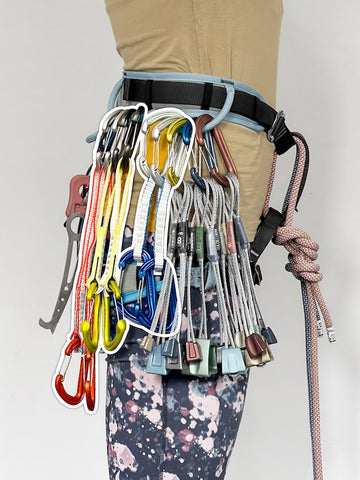How to Build Your First Trad Rack
Looking to get into trad climbing? To get started, you’ll need to learn the Tools of the Trad, what kit you need, and how to use it. We’ve put together a quick guide to help you get to grips with the right gear.
Your trad rack, and how you rack it, can be very personal and specific to the type of rock you climb and the type of climbing you do. Our gear suggestions should be taken as a starting point for your first trad rack, but we highly recommend you follow along with our Learning to Trad Climb series on YouTube for best practice on how to start out.

Nuts
Nuts are a versatile piece of rock protection and the foundation of any trad rack. DMM manufacture a range of nuts to fit all occasions, but for starting out we recommend a full 1-11 set of Wallnuts, which are designed to fit into tapered cracks, and a set of Alloy Offsets which are an irregular shape to fit into flared cracks.
How you rack these nuts is personal preference, but we recommend splitting the 1-11 set of Wallnuts into small and large on two WallDO or PerfectO carabiners.
The DMM Nutbuster nut key is also an essential piece of kit to help remove nuts when they become stuck.
Watch episode 2 to learn how to place and remove nuts

Quickdraws
Trad quickdraws connect rock protection to the rope. The top carabiner is loosely connected to the adjoining sling to allow for movement without dislodging the nut. The sling comes in different sizes to help with rope management and awkward rock protection placements. The bottom carabiner is coloured to help differentiate it to the top carabiner. The sling holds the carabiner in place to help with clipping and maintain correct orientation. For your starter kit, we recommend 10-12 Spectre quickdraws including a couple of 18cm and 25cm lengths.
Watch episode 4 for rope management

Cams
Dragon Cams are the ultimate piece of rock protection. Quick to place and designed to fit into parallel cracks, Dragon Cams can greatly increase your options for placing rock protection on Trad routes.
We recommend the 2-4 Dragon Cam set. This provides a range across common crack sizes. An extendable sling often means that there is no need for an additional quickdraw so we recommend racking them with colour matching Spectre carabiners.
Watch episode 2 to learn how to place cams

Hex style nuts
Torque Nuts are a type of passive protection just like Wallnuts and Alloy Offsets, but along with tapered cracks, they can also work in parallel cracks as with cams. Torque Nuts cam, or torque themselves due to their irregular hexagonal shape.
Like Dragon Cams, Torque Nuts have extendable slings, so we recommend a set of 1-4 Torque Nuts each racked on colour matching Spectre carabiners.
Watch episode 2 for how to place Torque Nuts

Slings and locking carabiners
DMM’s Dynatec slings come in a variety of thicknesses and length. 3-4 slings in different lengths from 60cm to 240cm will come in handy to use as protection, in threads or spikes, or to set up an anchor. Slings can either be wrapped up and clipped to the harness, or worn around the body, each connected by a screwgate carabiner such as a Shadow.
Watch episode 3 for how to set up an anchor

Belay device
A belay device is a fundamental piece of climbing kit, which allows you to control the rope without the full weight of the climber going through your hands. In trad climbing, belaying and abseiling with two ropes is commonplace. We recommend the Mantis with a Shadow HMS.





